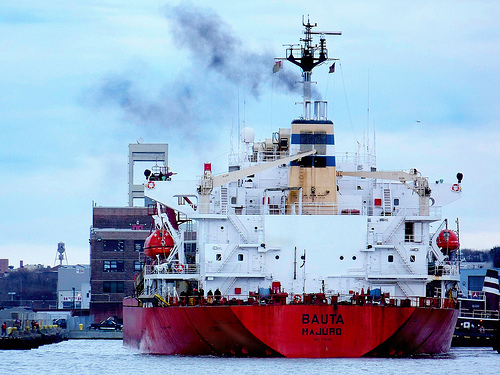
Bauta Docking by Flickr user PayPaul
Here at GreenCarReports.com, we mostly write about, you know, cars. But occasionally something so appalling comes across our desk that we want other people to know.
Today's candidate is an article from the British newspaper The Guardian. The headline decorously notes the health risks of the global shipping industry have been "understated". But once you dig into the data, the word understated hardly seems sufficient.
The bottom line: One giant container ship pollutes the air as much as 50 million cars. Yes, that's 50 million. Which means that just 15 ships that size emit as much as today's entire global "car park" of roughly 750 million vehicles. Among the bad stuff: Sulfur, soot, and other particulate matter that embeds itself in human lungs to cause a variety of cardiopulmonary illnesses.
Since the mid-1970s, developed countries have imposed increasingly strict regulations on auto emissions. In three decades, precise electronic engine controls, new high-pressure injectors, and sophisticated catalytic converters have cut emissions of nitrous oxides, carbon dioxides, and hydrocarbons by more than 98 percent. New regulations will further reduce these already minute limits.
But ships today are where cars were in 1965: utterly uncontrolled, free to emit whatever they like. Just one of many statistics: A car driven 9,000 miles a year emits 3.5 ounces of sulfur oxides--while the engine in a large cargo ship produces 5,500 tons.
And in the near term, very little is going to change. Why? Two reasons: Bunker fuel, and jurisdiction.
Bunker fuel, the stuff large cargo ships run on, is pretty much the dirtiest liquid fuel around. It's brown or black, and frequently so thick or sludgy it barely flows. Imagine cargo ships burning liquid asphalt, and you wouldn't be far off. Among other things, bunker fuel has up to 2000 times the sulfur permitted in the diesel fuel that's used for road vehicles. Compared to this stuff, gasoline is as carefully crafted as the finest French champagne.
Jurisdiction is the reason that cargo ships aren't regulated. Nations can only require ships to comply with domestic laws once they enter a coastal zone. After research on the health damage from shipping, the US last week extended its coastal jurisdiction as far as 230 miles from its shores.
But beyond coastal areas, the International Maritime Organization of the United Nations regulates shipping by 168 nations, which must adopt and abide by its rules. Last October, it finally got agreement that 90 percent of the sulfur must be removed from marine fuel by 2020, which it says will cut particulate emissions by half. Starting in 2011, it will also require newly-built marine engines to control particulate matter and nitrous oxides.
Meanwhile, want the grim punchline? There are now about 90,000 cargo vessels plying the waters globally. Not all emit as much as the hugest ships, of course. But if you assume the average ship is only one-tenth as bad as the giants, that means cargo vessels on the seas emit more than 500 times the total pollution of the world's vehicles.
After that, we don't quite know what to say.
SHIPPING BY NUMBERS (from The Guardian article)
The world's biggest container ships have 109,000 horsepower engines which weigh 2,300 tons.
Each ship expects to operate 24hrs a day for about 280 days a year
There are 90,000 ocean-going cargo ships
Shipping is responsible for 18-30% of all the world's nitrogen oxide (NOx) pollution and 9% of the global sulphur oxide (SOx) pollution.
One large ship can generate about 5,000 tonnes of sulphur oxide (SOx) pollution in a year
70% of all ship emissions are within 400km of land.
85% of all ship pollution is in the northern hemisphere.
Shipping is responsible for 3.5% to 4% of all climate change emissions

San Francisco Bay cargo ship, by Flickr user Bernard Garon
[SOURCE: The Guardian via TreeHugger; PHOTOS: Cargo ship by Flickr user Bernard Garon, Bauta Docking by Flickr user PayPaul]













